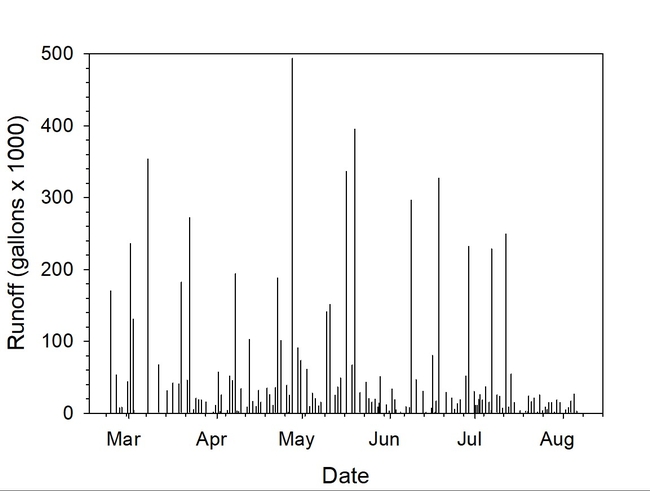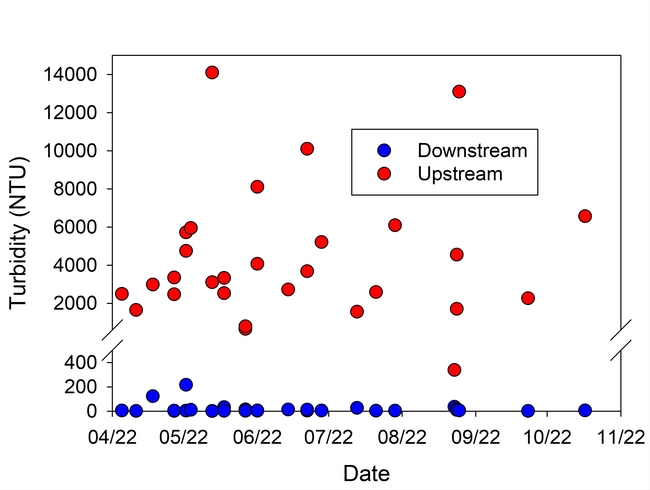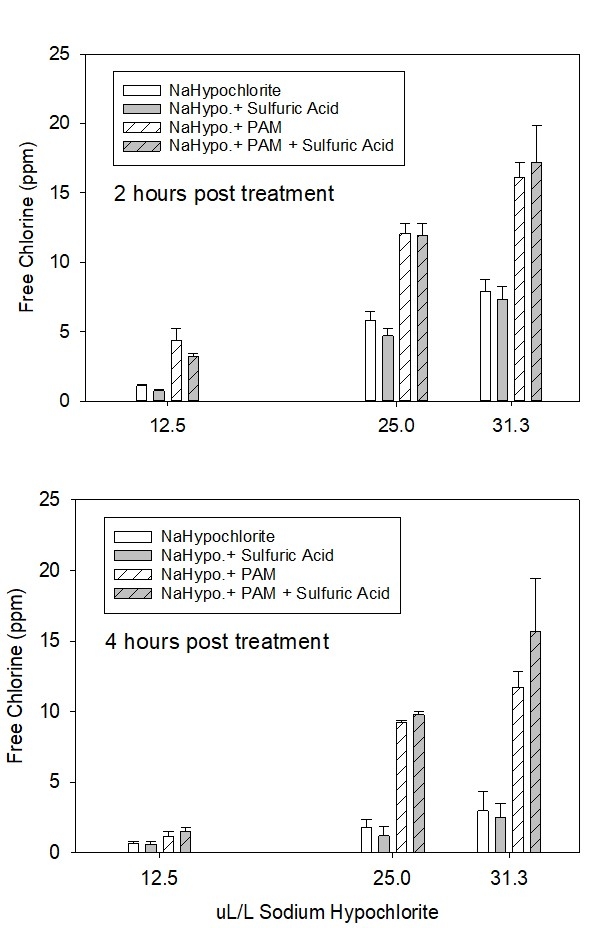- Author: Michael Cahn
- Contributor: David Chambers
- Contributor: Tom Lockhart
- Contributor: Noe Cabrera
Minimizing suspended sediments in irrigation runoff is desirable for several reasons. For growers reusing tailwater for watering their crops, they must assure that the water has minimal food safety risks by testing it for generic E coli and/or treating it with chlorine. The concentration of free (or reactive) chlorine is reduced when tailwater contains a high concentration of suspended sediments. Treating a large volume of tailwater with chlorine can be a significant expense over a season so it is important to be able to remove as much of the suspended sediments as possible before treatment.
A second reason is that water quality regulations under Agriculture discharge Order 4.0 requires tailwater discharged into public water ways to not be toxic to aquatic organisms. Pesticides that strongly bind to soil, such as pyrethroids, are carried on the suspended sediments in runoff which can cause toxicity to aquatic organisms that live in creeks and rivers downstream from farms. Also, particulate forms of N and P which bind with the suspended sediments pose a water quality risk to receiving waterbodies such as the sloughs and wetlands along the coast. Both nutrients can spur algal blooms which reduces dissolved oxygen available to fish and other aquatic organisms.
In a previous article we discussed a new approach to using Polyacrylamide (PAM), an inexpensive polymer molecule for reducing soil erosion, to treat sprinkler water. This practice uses a specialized applicator (Fig. 1) to condition water flowing from a well with PAM. An advantage of this method is that the cartridges in the applicator release a small amount of PAM (1 to 2 ppm) into the irrigation water, which flocculates soil particles that could potentially become suspended and transported in runoff. Field tests using a prototype version of this applicator resulted in about 90% less suspended sediment in the tailwater when treated with PAM compared to untreated irrigation water.
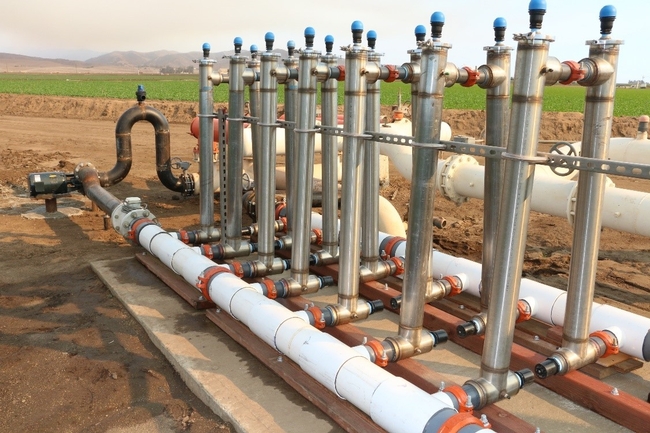
Auger ditch applicator
A second approach we developed for reducing suspended sediment in runoff is to use a smart applicator that can automatically apply dry PAM to the runoff water flowing in farm ditches. This type of applicator is suspended on a platform above a ditch and uses a hopper filled with dry PAM and an auger system controlled by an electric motor and small computer to drop PAM down a tube into the flowing runoff (Fig. 2). A weir and float mechanism located upstream are used to monitor the flow rate of the runoff so that the computer can adjust the frequency that PAM is applied. A video at this link demonstrates how the auger applicator operates.
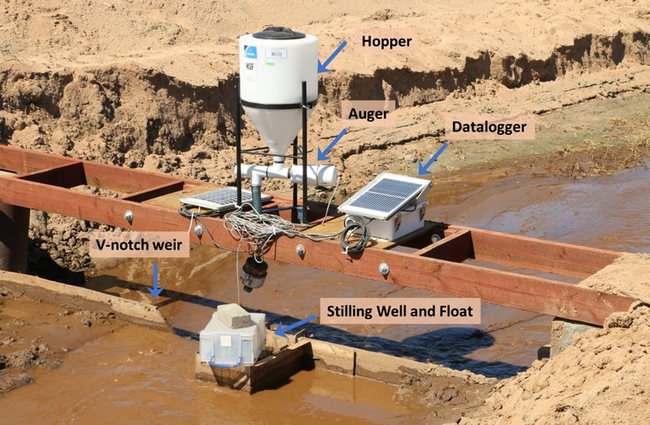
Field testing of the ditch applicator
A yearlong study at a commercial farm showed that the ditch applicator was effective in removing 98% of the suspended sediments transported in runoff (Table 1, Fig. 3). Based on the total runoff measured in a single drainage ditch during the 2022 season (21.5 acre-feet), an estimated 106 tons of sediment were removed (Fig. 4).
Turbidity in the runoff was reduced by more than 99%, and Total P and N were reduced on average by 89% and 60%, respectively, during the season (Table 1, Figs. 5 and 6). These reductions in nutrient load, suspended sediment, and turbidity could greatly improve water quality in water bodies downstream from farms that discharge irrigation runoff.
Table 1. Average concentration of N, P, and sediments carried in irrigation runoff before (upstream) and after (downstream) treatment with the PAM ditch applicator (April – October 2022). Average of 32 paired grab samples from 3 farm ditches. Downstream locations varied from 300 to 500 ft downstream from the PAM applicators.
Ditch applicator vs well applicator
Although more effective at reducing suspended sediment in runoff than the well applicator, the ditch applicator required more maintenance. PAM needed to be added to the hopper once or twice per week during the irrigation season, and sediment that settled in the ditches had to be cleaned out periodically using a backhoe. Also, removed sediment had to be spread back in the fields. The well applicator only required periodic refilling of the cartridges with PAM, and minimizes the amount of sediment that settles out in the drainage ditches.
PAM effects on chlorine requirement
To evaluate the effect of PAM on the quantity of chlorine needed to treat runoff, we performed a laboratory assay on samples of sprinkler runoff collected upstream and downstream of one of the ditch applicators. The turbidity of the upstream (untreated) and downstream samples (PAM treated) was 2276 and 9.5 NTU, respectively. The electrical conductivity of the runoff samples was 1.35 dS/m and the pH was 8.4 before adding chlorine. The main factors evaluated in the assay were sodium hypochlorite concentration and acidification with 10% sulfuric acid. Presumably, acidifying the runoff to a pH of 6.5 should increase the concentration of the more reactive form of chlorine, hypochlorous acid which is more effective as a microbial disinfectant. Residual free chlorine concentration of the treatments was evaluated 2 and 4 hours after adding 12.5% sodium hypochlorite at concentrations ranging 12.5 to 31.3 ul per liter of runoff (100 to 250 ul of 12.5% NaOCl per L of water).
The laboratory assay showed that reducing suspended sediment concentration using PAM increased the efficacy of chlorine treatment of runoff. The free chlorine concentration for PAM treated runoff was more than twice the concentration measured in the untreated runoff for all sodium hypochlorite concentrations evaluated after 2 hours and more than three times the concentration after 4 hours (Fig. 7). Free chlorine concentration in the PAM treated runoff was more than 2.5 ppm two hours after treatment at the lowest concentration of chlorine evaluated (12.5 ul/L) but was less than 0.5 ppm in the untreated runoff. To attain similar chlorine efficacy as PAM treated runoff, untreated runoff would require twice as much sodium hypochlorite (25 ul/L). These chlorine requirements would correspond to 26 and52 gallons of 12.5% sodium hypochlorite to treat and acre-foot of runoff with and without a PAM pretreatment, respectively.
Acidification of the runoff to a pH of 6.5 with sulfuric acid increased the free chlorine concentration in the PAM treated runoff at the highest concentration of sodium hypochlorite (31.3 ul/L) after 4 hours. Acidification did not have a significant effect on free chlorine concentration for the other treatments.
Summary
Both versions of the dry PAM applicators (well and ditch) show promise for greatly reducing soil erosion, as well as helping improve water quality and the efficacy of chlorine for treating tail water reused for irrigation. By considerably reducing the concentration of suspended sediment in irrigation runoff, chlorine can be more effective as a disinfection agent, and better control E. coli and other microbial pathogens that could potentially cause public health risks.
Acknowledgments: We greatly appreciate assistance in fabricating the prototype PAM applicators from RayFab. This project was funded by the California Leafy Green Research Board.
Further reading
Richard Smith1, Eric Brennan2 and Patricia Love1
1. University of California Cooperative Extension, Monterey County. 2. USDA-Agricultural Research Service, Salinas.
Fall-grown cover crops (planted August-September and incorporated October-November) provide a useful planting slot for a percent of vegetable crop acreage in the Salinas Valley. It is a time when some growers find an opportunity, after two crop rotations, to fit a cover crop in their operations. It has the particular advantage of allowing the grower to incorporate the cover crop and still have time to work the ground when it is still dry before the onset of winter rains.
In Ag Order 4.0 which was approved in April 2021, cover crops that meet the following criteria were granted a credit on the R side of the applied (A) minus removed (R) metric for nitrogen loading in vegetable production fields: 1) a non-legume cover crop grown for ³ 90 days during the winter fallow period (October to April); 2) accumulates more than 4,500 lbs/acre of oven-dry biomass; and 3) has a C:N ratio of ³ 20:1 at incorporation. Unfortunately, fall-grown cover crops do not meet these criteria and therefore growers cannot claim a credit when reporting nitrogen loading in their fields.
In the fall of 2021, we conducted six on-farm evaluations of fall-grown cover crops to determine their productivity, nitrogen scavenging capability and C:N ratio at incorporation. Planting dates ranged from August 25 to October 3, and the average days to incorporation was 54 (ranged from 47 to 59). Two barley varieties UC 696 and UC 937, as well as Merced rye were planted in each evaluation. The barley varieties were included because we anticipated that they would reach the heading growth stage more quickly than rye when growers typically terminate cover crops. However, in these evaluations, barley did not reach this stage any faster than Merced rye as measured by the Feekes cereal growth and development scale (Table 1). In 54 days, all cover crops produced more than 4,500 lbs oven-dry biomass and took up from 150 to 161 lbs N/A. The C:N ratios of the cover crops ranged from 13.0 to 13.4.
Fall-grown cover crops grow and mature quickly due to the longer days and warmer weather that they experience in these early planting slots. An important question is, do fall-grown cover crops help to reduce nitrogen leaching during the winter? To help answer this question, we intend to conduct mineralization studies of the cover crop residue to determine what amount of the residue remains unmineralized after twelve weeks. The nitrogen in the unmineralized portion of the cover crop residue is not immediately susceptible to nitrate leaching and could potentially be deserving of a credit. The Central Coast Regional Water Quality Control Board will update the criteria in the Ag Order each five years based on new scientific information. If there is evidence that fall-grown cover crops can help mitigate nitrate leaching, this may help to justify expanding cover cropping options for growers in the Ag Order.

- Author: Michael D Cahn
CropManage Hands-on Workshop:
Bringing Irrigation and Nutrient Management Decision Support to the Field
Date: Tuesday, April 24, 2018
8:00am – 12 pm
Location: Monterey County Agriculture Conference Room
1432 Abbott St. Salinas, CA 93901
- Learn how to use CropManage to support irrigation and nutrient management decisions and record-keeping
- Learn the new version of CropManage (3.0) – also available in Spanish
CropManage is a free online decision support tool for water and nutrient management of coastal crops. Based on in-depth research and field studies conducted by the University of California, CropManage provides real-time recommendations for efficient irrigation and fertilization applications— while maintaining or improving overall yield.
At this free workshop, we will provide hands-on training so that you can learn to use the newest version of CropManage (3.0) which has been updated to be more compatible for in-field use by farm staff. CropManage is now available in Spanish.
Crops currently supported by CropManage include strawberry, raspberry, head, romaine, and leaf lettuce, broccoli, cauliflower, cabbage, celery, bell peppers, spinach, baby lettuce, cilantro, and mizuna.
Who should participate? Vegetable and berry growers, ranch managers, other farm staff, and technical service providers are welcome. The workshop is for both new and current CropManage users.
What to bring? This is a participatory workshop. Please bring a tablet or laptop computer so that you can follow along and participate in the exercises. Each participant will need a user account for CropManage. Please set up a free user account at v3.cropmanage.ucanr.edu before the workshop.
RSVP by Friday, April 20, 2018 to Lennis Arriaga at larriaga@ucanr.edu or 831 759-7353.
AGENDA
8:00 – 8:30 Registration and computer set-up
8:30 – 10:15 Getting started with CropManage 3.0
10:15 BREAK
10:30 – 11:15 Strategies for using CropManage for decision support and record-keeping
11:15 - 11:45 Advanced features and interfacing sensors with CropManage
11:45 -12:00 Discussion of new features or changes needed
2.5 Continuing Education Units (CEU) available for Certified Crop Advisers (CCA)
- Author: Michael D Cahn
- Author: Richard Smith
2018 UCCE Irrigation and Nutrient Management Meeting
Monterey County Agricultural Center
1432 Abbott Street, Salinas, CA
Tuesday, February 13
7:45 a.m. to 12:30 p.m.
7:45 Registration (Free)
8:00 Update on the Ag Order for the Central Coast.
Chris Rose, Senior Environmental Scientist, Irrigated Lands Regulatory Program Manager, Central Coast Water Board
8:30 Soil nitrogen dynamics in long-season vegetable crops
Richard Smith, Vegetable Crops Farm Advisor, Monterey County
9:00 Fall application of high C:N ratio amendments to immobilize soil nitrate
Joji Muramoto, Associate Researcher, Dept. of Environmental Studies, UCSC
9:30 On-farm trials evaluating the fertilizer value of nitrate in irrigation water
Michael Cahn, Irrigation and Water Resources Advisor, Monterey County
10:00 Break
10:30 On-farm management practices for mitigating insecticides in irrigation run-off
Laura McCalla, Department of Environmental Toxicology, UCD, Granite Canyon Laboratory
11:00 Microbial food safety risks of reusing tail water for production of leafy greens
Anne-laure Moyne, Staff Research Associate, Food Science and Technology Dept., UCD
11:30 Update on seawater intrusion in the Salinas Valley Aquifer
Howard Franklin, Senior Hydrologist, Monterey County Water Resources Agency.
12:00 Conclusion and Pizza Lunch
3.5 CCA & 0.5 DPR continuing education credits have been requested
- Author: Michael D Cahn
If you missed the 2015 Irrigation and Nutrient Meeting or you would like to review the presentations, you can download pdf versions of the powerpoint files from the UCCE Monterey County Website (http://cemonterey.ucanr.edu). The direct link to the presentations is:
http://cemonterey.ucanr.edu/Vegetable_Crops/2015_Irrigation_-_Nutrient_Management_Meeting_
We want to thank all of you who attended for your participation and for the many constructive comments that we received verbally and through the evaluation surveys. Let us know of any topics that you would like us to address in the next irrigation and nutrient management meeting or ways to improve the meeting.
If you are interested to learn more about CropManage for improving irrigation and nutrient management, I plan to host a hands-on training on using this on-line decision support tool on April 2nd. I will send out a formal announcement in the upcoming weeks.



